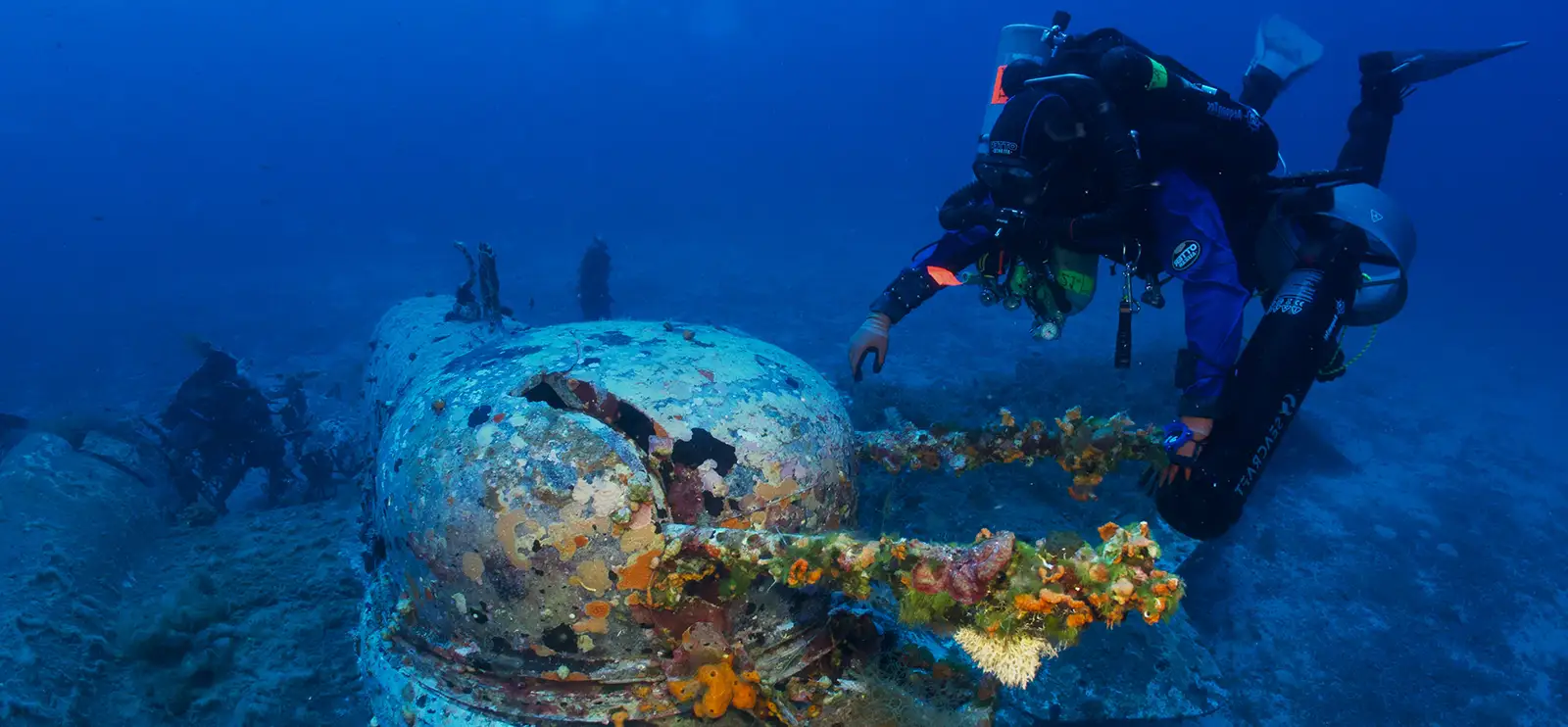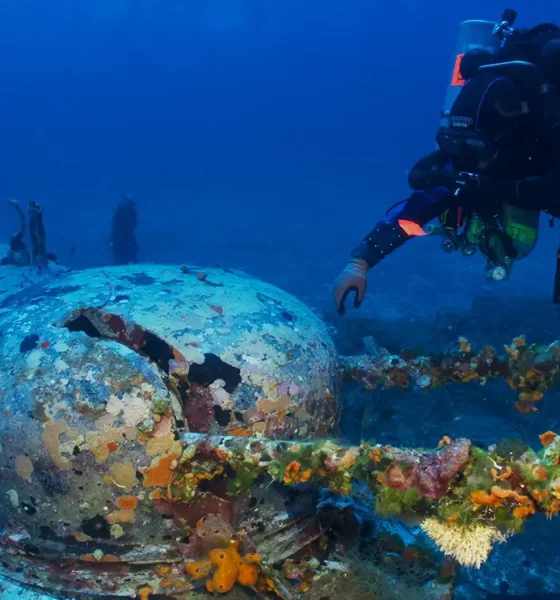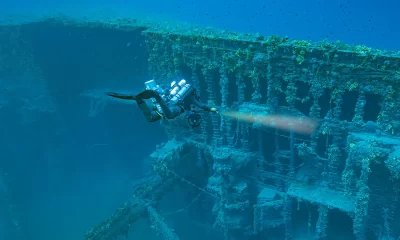

Latest Features
Finding A Martin Baltimore in Antikythera
Marinos Giourgas and his AegeanTec team have been racking up finds, exploring WWI & WWII shipwrecks and downed aircraft in the Mediterranean. Here’s his report on their recent discovery of a WWII Baltimore off Antikythera that they have been searching for since 2017.
By Marinos Giourgas. Images courtesy of the author. Lead image: The author examining the turret with the machine guns of the Martin Baltimore.
Antikythera is a small island located between the Peloponnese peninsula and the island of Crete. It is famous for the ancient Greek hand-powered mechanism used as a model of the solar system which was discovered off its east coast by a group of sponge divers from Symi in the early 1900s. But is this all this tiny island hides under the surface of the Aegean Sea? We were determined to find out.
The Martin Baltimore was a twin-engined light attack bomber designed and built in the United States in the 1940s. This aircraft undertook a variety of missions in the Middle East, Mediterranean, and European Theaters, including reconnaissance, target-towing, maritime patrol, night intruder, and even served as highly uncomfortable fast transport. No. 454 Squadron Royal Australian Air Force (RAAF), part of RAAF Middle East Command’s 201 Group, was based at RAF El Amiriya in Egypt, and had the role of maritime patrol squadron.

Operating in the Mediterranean Theater for almost a year and a half, No. 454 Squadron attacked targets in Greece and Crete, concentrating on anti-submarine patrols and striking merchant shipping, operating from several different locations including Amiriya, landing ground RAF Gambut III, RAF St Jean, and Berka III using the Martin Baltimores from 1943 to 1945.
On the December 3, 1943, the RAAF Baltimore with Pilot Officer William Alroy Hugh ‘Alan’ Orsley, Pilot Officer Colin William Walker, Warrant Officer John ‘Shorty’ G Artside from the Royal New Zealand Air Force (RNZAF), and retired veteran Flight Lieutenant Leslie Norman Ro, was concluding its reconnaissance flight over the Aegean islands taking aerial photos of the position of the fleet of the Axis Powers when two German Me 109 spotted and pursued it.
The Baltimore managed to escape from the two German aircraft and started a low flight route from the island of Serifos towards the island of Antikythera which was used as a waypoint by the Allied Air Forces airplanes on their return to their bases on the North coast of Africa—in this case in Amiriya, Egypt.
Upon approaching the waypoint and while on a visual with the island of Kythera, another pair of German Me 109s spotted the Baltimore. The flight plan used by the Allies during their operation over the Aegean Sea had been carefully analyzed by the Germans who were observing the airplanes from their various bases on the Greek Islands. The plan to intercept the Allied aircrafts was carefully prepared by the Germans, and they had made modifications to the Me 109s to patrol the area more efficiently.
On Crete, the two Messerschmitts from Jg 27 attacked the Baltimore seven times with severe blows to its structure, and its left wing burst into flames. The pilot decided to ditch the aircraft near the north coast of the island of Antikythera and prepared himself and the crew by removing the canopy. According to his report, he hit his head during ditching, passed out, and recovered when the water was up to the level of his neck only to realize that the airplane was going down nose first.
He got out of the Baltimore and started swimming while looking for the other members of his crew, but he could not see anyone. He swam for about 250 m/820 ft and ended up on a rock on the north shore of the island of Antikythera. From there, he was saved by a local fisherman and surrendered to the German island guard and ended up as a POW at Stalag.

Our First Attempts to Find the Wreck
In August 2017, our wreck researchers G. Karelas and N. Karatzas went to Antikythera and gathered some information from the locals about a Martin Baltimore airplane that was believed to be resting on the seabed. They managed to locate the son of the fisherman who had rescued Pilot Officer Orsley from the rock after he swam the distance from the ditched airplane to the shore on December 3, 1943. This meeting gave us a rough idea of where to search for the missing aircraft but, due to heavy weather, it was not possible to dive on that day.
The project was now locked in our minds, and we needed to go back to Antikythera and start our search. Last June, the AegeanTec team got involved and, after securing the right equipment from V. Mentogiannis, we joined forces with G. Lampoglou and his Kythera Dive Center and visited the little island in order to start our research. The results of our efforts with the sonar were inconclusive; we managed to locate several possible targets for further investigation, but none of them gave us the certainty that it was the missing Baltimore.

On the way back from this trip, we were already looking for a way to go back and start all over again. However, the trip to this tiny island from our base in Athens is not an easy one and we had to make sure that next time we will be better prepared. The local community played a significant role all this time and they were keen on helping us. Mr. George Harhalakis, the Head of the local community, Mr. N. Konstantinidis, Mr. A. Harhalakis, and local fishermen all embraced our efforts and supported us in finding the spot.
Finding A Martin Baltimore
In mid-July, the divers of AegeanTec were back in Antikythera ready to explore the possible targets locked by our sonar and based on the information from the locals. We dived the area of interest in the early morning of July 14, 2024. We had prepared a plan for a dive to 70-75 m/230-246 ft and, together with Vasilis Spyropoulos (our underwater photographer), we entered the water eager to find out what the Aegean Sea was hiding from us. The shot line landed next to an aluminum piece of a fuselage and we were sure that the Baltimore was somewhere there.
The DPVs were in full swing and, after about 5 minutes of cruising at a depth of +60 m/200 ft, we saw a shadow that accelerated our heartbeats. Is this what we had been looking for the last seven years? Is this the Martin Baltimore that met its destiny 81 years ago? As we were approaching the shadow, we realized that we stumbled across a new wreck—not an airplane but possibly a small sailing cargo vessel of about 40 m/130 ft in length that had been resting there for an undetermined number of years.
This wreck requires further investigation to unveil its story, but this was not our mission on that date. With mixed feelings, we continued our search with the DPVs and, about two minutes away from the newly discovered wreck, we saw another shadow with a prop blade sticking out from the rest of the structure. Yes! That was an airplane!



We approached the structure, and it was exactly what we were expecting it to be. A Martin Baltimore with the front section in bad shape, parts missing, and pilot canopy removed: exactly as the pilot described in his report. We also spotted the 2 × 0.303 in (7.7 mm) machine guns in the dorsal turret sticking out, ready to face enemy aircrafts. The fuselage was in very good condition and (compared to other wrecks that I have dived in the past) it was not covered with the usual amount of marine life.
The section between the dome with the machine guns and the rear wing was in bad shape, and a big part of it was missing. We believe this was due to either the plane landing on the seabed or the actions of fishing trawlers in the area. From the broken areas of the rear and front section of the aircraft, we were able to see the interior space of the fuselage and took several photos to document this finding.
The seats of the pilot and the crew helped to remind us of the brave men who were once flying in the European skies fighting to restore peace and freedom on the continent. No human remains were spotted inside the airplane, but much of the airplane’s equipment—the throttle levers, rudder pedals, instruments, fire extinguisher base, and other parts covered with marine life—were visible to us.
The blades of the propellers were all bent indicating that the aircraft ditched to the surface of the water in a violent way and possibly not under the full control of the brave pilot resulting in the breaking apart of the missing front section of the aircraft. The two machine guns sticking out from the turret on top of the fuselage were intact and still pointing against the enemy Me 109 aircrafts chasing the Baltimore.



Other Observations
During our dives, we noticed that the fuselage was extremely narrow, making it impossible for the crew members to change positions, if required during the flight. From what we read about this type of aircraft, the crew members complained about the cramped conditions in the Martin Baltimores, and this was the case in earlier Maryland bombers as well. The two wings were not broken and looked in good shape. The left wing had a different, darker color than the right one, probably because of the fire caused by the two attacking German Messerschmitts that were pursuing the Baltimore.
We did not locate any other identified physical components on the site: ID plates or serial numbers, for example. However, after studying the records and discussing with the son of the rescuer fisherman, this Baltimore is believed to be the FW282:P that ditched off Antikythera on December 3, 1943. Our team conducts these dives with the purpose of documenting these wrecks so that future generations can learn and appreciate the history of their land. We also seek to pay our respects to all those brave people who took part in these fierce battles.
Our endeavor in the Aegean Sea off Antikythera was fully supported by both the local community and the authorities, and we thank them for appreciating our efforts. Special thanks to John Womack and Otter Drysuits for supporting AegeanTec. This trip to Antikythera was made for the extra purpose of immersing the new Otter Aegean Drysuit for the first time as we could not think of a better place to do so than deep in the Aegean Sea!
Mission Accomplished
Our mission was successful not only because of the two new wrecks we found but also because we discovered more attractions and history on the island of Antikythera than just its unique wrecks and the ancient Greek analogue computer. This could be the first step in making Antikythera a new diving destination in Greece for the international technical diving community.
DIVE DEEPER
InDEPTH: A Report on Greece’s Vickers Wellington Wreck by Marinos Giourgas
InDEPTH: A Greek JJ-Palooza on HMS Ermine by Marinos Giourgas
InDEPTH: A Dive into Malta’s UW Cultural Heritage with Timmy Gambin by Michael Menduno
InDEPTH: Finding a P38 Lightning by Fabio Giuseppe Bisciotti
InDEPTH: Surveying and Identifying a Sunken JU 88a German WWII Aircraft by Fabio Giuseppe Bisciotti

Marinos Giourgas is an active PADI, TDI, and IANTD technical and rebreather diving instructor based in the southern coast of Athens, Greece, and he is a brand ambassador for Otter Drysuits. He started his diving career in the 1990s and, since then, his enthusiasm has allowed him to connect with nature. His passion for adventure and WWI & II wrecks has made it possible for him to participate in several expeditions in the Greek Seas to discover and explore the underwater relics of the past. He is the founder of AegeanTec, a team of avid divers offering technical, trimix, and CCR diver training. He manages the technical diving section of one of the biggest dive centers in the southeast coast of Athens, providing training and guiding tekkies to unspoiled dive sites that only few—if any—will ever see. Free time for him is spent pursuing alpinism and mountain biking.
























































